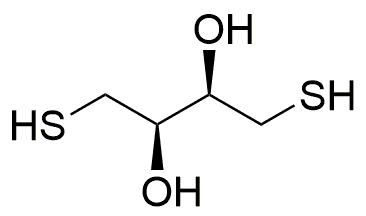1,4-Dithio-DL-threitol is widely utilized in research focused on:
- Antioxidant Applications: This compound acts as a potent antioxidant, helping to protect cells from oxidative stress. It is particularly valuable in biomedical research for developing therapies against diseases linked to oxidative damage.
- Pharmaceutical Development: Its unique chemical structure allows it to be used in the synthesis of various pharmaceutical agents, enhancing drug efficacy and stability in formulations.
- Biochemical Assays: Researchers employ it in biochemical assays to study redox reactions and enzyme activities, providing insights into metabolic pathways and disease mechanisms.
- Cosmetic Formulations: The compound is incorporated into cosmetic products for its skin-protective properties, helping to improve skin health and appearance by combating free radicals.
- Food Preservation: It is also explored as a natural preservative in the food industry, where it helps extend shelf life by preventing oxidative spoilage, making it a safer alternative to synthetic preservatives.
General Information
Properties
Safety and Regulations
Applications
1,4-Dithio-DL-threitol is widely utilized in research focused on:
- Antioxidant Applications: This compound acts as a potent antioxidant, helping to protect cells from oxidative stress. It is particularly valuable in biomedical research for developing therapies against diseases linked to oxidative damage.
- Pharmaceutical Development: Its unique chemical structure allows it to be used in the synthesis of various pharmaceutical agents, enhancing drug efficacy and stability in formulations.
- Biochemical Assays: Researchers employ it in biochemical assays to study redox reactions and enzyme activities, providing insights into metabolic pathways and disease mechanisms.
- Cosmetic Formulations: The compound is incorporated into cosmetic products for its skin-protective properties, helping to improve skin health and appearance by combating free radicals.
- Food Preservation: It is also explored as a natural preservative in the food industry, where it helps extend shelf life by preventing oxidative spoilage, making it a safer alternative to synthetic preservatives.
Documents
Safety Data Sheets (SDS)
The SDS provides comprehensive safety information on handling, storage, and disposal of the product.
Product Specification (PS)
The PS provides a comprehensive breakdown of the product’s properties, including chemical composition, physical state, purity, and storage requirements. It also details acceptable quality ranges and the product's intended applications.
Certificates of Analysis (COA)
Search for Certificates of Analysis (COA) by entering the products Lot Number. Lot and Batch Numbers can be found on a product’s label following the words ‘Lot’ or ‘Batch’.
Número de catálogo
Número de lote/lote
Certificates Of Origin (COO)
This COO confirms the country where the product was manufactured, and also details the materials and components used in it and whether it is derived from natural, synthetic, or other specific sources. This certificate may be required for customs, trade, and regulatory compliance.
Número de catálogo
Número de lote/lote
Safety Data Sheets (SDS)
The SDS provides comprehensive safety information on handling, storage, and disposal of the product.
DownloadProduct Specification (PS)
The PS provides a comprehensive breakdown of the product’s properties, including chemical composition, physical state, purity, and storage requirements. It also details acceptable quality ranges and the product's intended applications.
DownloadCertificates of Analysis (COA)
Search for Certificates of Analysis (COA) by entering the products Lot Number. Lot and Batch Numbers can be found on a product’s label following the words ‘Lot’ or ‘Batch’.
Número de catálogo
Número de lote/lote
Certificates Of Origin (COO)
This COO confirms the country where the product was manufactured, and also details the materials and components used in it and whether it is derived from natural, synthetic, or other specific sources. This certificate may be required for customs, trade, and regulatory compliance.


